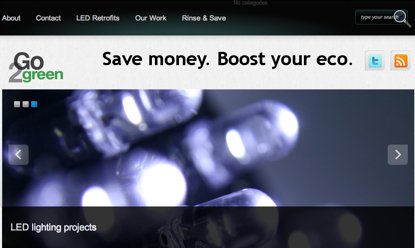Most small business owners wouldn’t naturally think about swapping out their exit signs for more eco-friendly ones as an obvious place to start greening their workplace.
But that’s what an Evanston startup is banking on as one of the initial services they’re offering other small businesses, schools and organizations that are too busy to green up on their own. Since February, Go to Green LLC has replaced more than 500 exit signs for businesses and schools in Chicago and Evanston. More than 100 were sold as part of a group offering to eco-Andersonville, a program of the Andersonville Development Corp., which offers a variety of initiatives to its members to encourage them to be more environmentally friendly.
Paige Finnegan, a co-owner of Go to Green, estimates the retrofit to signs using LED light bulbs saves businesses about $868 in energy and maintenance costs over the lifetime of the new sign, or about 10 years. Companies that sign up also get a $20 per-sign rebate from Commonwealth Edison and Ms. Finnegan secured a waiver for the permit fee from the city of Chicago for the retrofit.
Some of the small businesses already signed up for retrofits include Green Genes, The Runner’s Edge, Toujours Spa & Salon, and In Fine Spirits. Other organizations include the Unity Lutheran Church and Swedish American Museum, both in Andersonville.
Go to Green is also partnering with local gas utilities to offer restaurants and other food service operations free low-flow, pre-rinse sprayers to replace older, less-efficient ones. The Rinse & Save Campaign, only available till the end of May, is expected to save participants about $500 a year in natural gas and water savings, says Ms. Finnegan. She’s hoping the program will be extended beyond the end of the month.

Caitlin Dorsey and Paige Finnegan
Ms. Finnegan and co-owner Caitlin Dorsey intend to add more services over time, including water conservation opportunities.
Crain’s met up with Ms. Finnegan to learn more about this niche green-service provider.
Crain’s: Can you describe the concept behind Go to Green?
Ms. Finnegan: We’re trying to be one source that small businesses can come to for sustainability projects. We can bundle services together and give companies looking to go green a tremendous return on investment, sometimes in areas they might not be thinking about.
Take exit signs, for example. They’re on 24 hours a day and they use incandescent bulbs that have to be changed four times a year. With a retrofit, the new LED (light-emitting diode) bulbs last 10 years and can save a business about $868 over the life of that sign. ComEd offers rebates for a whole assortment of energy reduction projects and companies can go directly to ComEd to get this money, but it’s a process. We’re a partner with ComEd in a trade ally program so we’re able to do this process smoothly for companies that don’t have the time to bother. We’ve converted about 10% of those exit sign projects into a bigger lighting retrofits. Exit signs are the gateway drug to sustainability.
In the end, we want to make sustainability acceptable for small business through low-cost investment, high savings opportunity and bundle that with public relations benefits.
How does the public relations piece of it work?
In our work with eco-Andersonville, we can aggregate the reduction in energy use, reductions in greenhouse gas emissions, and spread that across the community. Instead of one small business making a change, it can be part of something bigger and get a PR boost out of it. Eco-Andersonville set a goal to get 200 new exit signs installed across many businesses, schools and other organizations. If they hit that goal, they’ll be able to achieve a 500,000-pound reduction in greenhouse gas emissions over the 10-year life of the bulbs. That’s more compelling than one small business doing it alone.
The aggregation extends beyond the positive environmental impact. We can bundle the purchase of the exit signs and the installation so the overall price drops and the entire community that’s participating gets a better deal. Even individual business owners not part of the eco-Andersonville program can let consumers know about the green changes they’re making since many are now looking to spend their money on green businesses wherever possible.
What kinds of businesses are you targeting for your services and what neighborhoods of the greater Chicago area are you focusing on?
We like storefronts, local independently owned businesses that will benefit from improvements in the local environment and get economic and PR benefits from these programs. The larger chains aren’t much of a target for us.
Because of where we’re located, we’re doing a lot of business in Evanston, but we have a relationship with eco-Andersonville and others, including the Belmont Central Chamber of Commerce. We’ve worked with the Wicker Park/Bucktown Chamber of Commerce, which has been sending out information to its members. We’ve had some interest in Bronzeville and we’re talking to people in Logan Square right now, too.
What other programs are you offering?
In Evanston, there’s a new program called Every Drop Counts. It’s an effort to retrofit bathrooms with faucet aerators and toilet tank diverters. You can do this with any existing fixture a company or building owner already has. So far, we’ve had lots of luck working with sorority and frat houses. They’ve grown up with the environmental ethic and they don’t have to be told it’s the right thing to do.
Water is the next big issue. We take advantage that we live next to this huge pool of water. It’s hard for people to see what an issue water is, but every year water prices go up and there’s a finite amount of water on our planet. Here, we pay for water in three ways: when it comes in, then the sewer cost for when it goes back out, then we pay electricity to pump the water. If you’re using hot water, there’s the cost to heat that water, too. So any reduction in water use reduces those costs. Water issues already are contentious on the West Coast and it’s on the cusp of becoming a much larger discussion, even locally.
Why aren’t more smaller businesses implementing some of these easy retrofits?
While what we’re doing isn’t that expensive, it’s still a cost to businesses. They’d need to do a lot of research to find these programs and how to get access to them. Most people never even look at their exit signs unless there’s a write-up from the fire department.
One of our biggest challenges for our work is how do we get a business owner to fix something that might not be broken? Unfortunately, not all businesses are doing this because it’s environmentally sound. But when they see a compelling economic savings and the performance of the equipment is the same or better, they’re usually sold.


